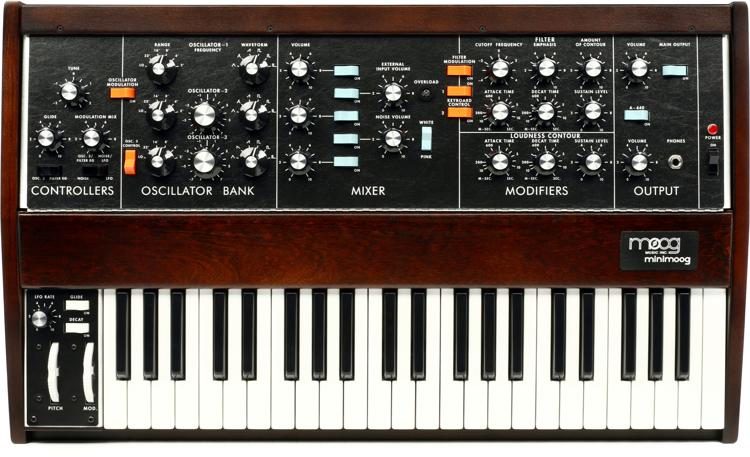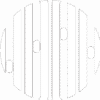Last Updated on February 28, 2023 by IDS Team
From guitar synths to analogue, additive, to wavetable, the world of synths is like learning a new language, especially if you come from a background playing guitar or bass. This handy guide will break down what’s out there and how to use them.
Additive vs Subtractive Synthesis: What’s the Difference?
Synthesisers can sculpt sound waves in two ways, either by adding new frequencies and harmonics to the original wave (additive synthesis), or by taking them away as needed (subtractive synthesis).
The vast majority of analogue synths are subtractive. Digital and FM synthesis nowadays also tends to be subtractive too. However, additive synths are very popular and can be one of the best for beginners as they tend to be simpler.
Guide to Synths for Guitar Players: Analogue Synthesis
Analogue synthesis made up all synthesis in the 1970s and early 1980s, and creates sound mechanically, as opposed to digitally with a computer. It’s famous for generating lush, warm tones.
Example Analogue Synths:
- Moog Minimoog
- Arturia Minibrute
- Korg MS 20

What it sounds like and how you can use it:
Analogue is easy to recognise and includes legendary brands like Moog as well as newcomers like Arturia. Ultimately if you want thick, fat sounds, you can’t go wrong with analogue. It’s favoured by classic rock but can also work for genres from industrial rock and metal, to pop rock, soul, and RnB.
FM Synthesis and the Sound of the ’80s
FM stands for frequency modulation and was made famous by Yamaha with the Dx7 in the 80s. What makes it stand out is like additive, subtractive, and wavetable synthesis, it’s one of the fundamental ways of generating sound in the first place.
One thing which sets FM synthesis apart is just how many combinations of parameters there are, but once you get the hang of it, it’s not as hard as expected.
Example FM Synths;
- Yamaha DX7
- Arturia DX7 V (an emulation of the classic DX7)
- Korg Volca FM 2
What it sounds like and how you can use it:
In some ways, FM summed up the sound of the 80s. It’s great to use in New Wave and featured in the work of bands like A-ha. It also works well for modern genres like indie pop when paired with clean guitars.
Ring Modulation: The Secret to Super Thick, Layered Sounds
Not a type of synth per se but a module in the signal chain. Ring Modulators take into account negative frequencies, and blend them via multiplication with the positive. This leads to creative permutations where waves cancel each other out to make futuristic and technological sounds, earning it a mention here for its totally different way of operating.
What is sounds like and how to use it:
Ring modulation is great for robotic noises or the sounds of glitching. However, with ring modulation, every time you use a waveform other than a pure sine wave, you multiply layers of frequencies, undertones, and overtones. This means it’s amazing for making super lush, creamy sounds, so use it whenever you feel something needs a little extra richness.
Guitar Synths: A Must Know for Any Guitarist Interested in Synthesis
The term ‘guitar synths’ can be confusing. These aren’t just regular synths which can emulate the noise of a guitar. Instead, after the invention of MIDI allowed instruments to share a common language, guitar players were then able to control synths from their guitar.
This requires a hexaphonic pickup, which goes between the guitar bridge and bridge pickup. From here, it sends the sound of each string separately to your machine of choice. Ultimately, this is what lets you ‘play’ a synth from your guitar.
Guitar synths have gained a reputation for being a bit ‘cheesy’ or ‘weird’. However, many classic bands used them, including Led Zeppelin, King Crimson, and, controversially, Iron Maiden on their 1988 release Seventh Son of a Seventh Son. Sound varies depending on the individual synth, but a few of the best choices include:
- The Boss SY-200 and Boss SY-300
- The Analogue Guitar Microsynth and the Mono Synth, both from Electro-Harmonix
- Keeley Synth-1 Wave Generator
One thing to bear in mind is you will have to buy the hexaphonic pickup separately. Otherwise, guitar synths are a great introduction to using synth sounds for guitarists whenever you need extra inspiration.
Granular Synthesis – Where Sampling and Synthesis Meet
Granular synthesis didn’t get its lucky break until the 1980s, with Canadian composer Barry Truax. However, even today granular synthesis doesn’t tend to feature as much as other kinds.
Granular synthesis is all about the samples. It’s generally digital, and splits up the sound into particles called microsounds before recombining them, leading to ultra unusual sounds. If it’s space age, avante-garde, or outside of the box you want, granular is a great option and we break down how it works further here.
Famous Examples of Granular Synthesis:
Despite being less well known, granular synthesis has become a highlight for many great creative new brands like these below:
- Bastl music GrandPA and MicroGranny (some of the best recent contenders)
- 1010 music’s Lemondrop Synth
- Portal Granular synth plugin, which we cover here
- Mutable instruments Clouds (one of the most popular!)
What it sounds like and how you can use it:
One of the quirks of granular synthesis is that it gives you very different results depending on tempo. For low tempos you can create lush dreamscapes. Alternatively, speed things up for more clean cut notes with out of this world timbres and textures. It can work for anything gritty and industrial or retro-futuristic, and you can use it for electronic or video-game inspired music. In fact, it’s a favourite for niche subgenres of EDM beatmaking, and in game and soundtrack composition for it’s glitchy noises.
Synths for Guitar Players – What is Modular Synthesis?
Modular synths, like FM synths, have a reputation for being difficult but is actually simple when broken down. A modular synth is made of different modules which function as separate component parts, giving you huge scope to alter the signal chain. These modules may be VCFs, VCOs, or envelope generators. They can also include more unusual offerings such as sample and hold modules.
Famous Modular Synths:
- Moog Mother
- Buchla modular Electronic Music System
- Roland System 100
What Does it Sound Like?
Modular synthesis doesn’t have just one sound as each synth is unique. Modular synths can be analogue or digital, the only difference being the way each individual module generates noise. In fact, this means that you can also get semi modular synths with both digital and analogue modules.
How to Use it With Guitar:
As modular synths can be so varied, it can work in many different genres. Therefore, how you use it depends on what exactly you’ve got…
Wavetable Synthesis
The first wavetable was the PPG wave, which came onto the scene in the 1980s, making Wavetable a relative newcomer to the world of synthesis.
Wavetable accomplishes with digital things which analogue can’t do. It captures the cycle of a single sound wave and sculpts it into different sounds by storing the different waveforms as a file where a traditional VCO would be. If you want to try it, there are great options for both hardware and VSTs.
Popular Examples of Wavetable Synthesis:
- PPG Wave
- Arturia Pigments 3
- Xfer Serum (VST)
- Waldorf M
What it Sounds like and How to Use It:
Despite its 80s roots, wavetable features heavily in modern electronic music, EDM, pop, and more. However, that doesn’t mean you can’t use it with guitar! It can work great in electro pop when paired with backing guitar but equally in industrial music.
Final Thoughts
This is just the tip of the iceberg when exploring different kinds of synths. However, for guitarists who want to branch out or even beginner musicians, this is a rough guide to knowing your analogue from guitar synths, ring modulation, and more.
Like more tutorials, cheatsheets, and rough guides? Check out our tutorials section here.



